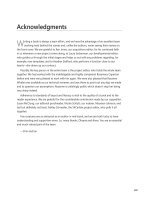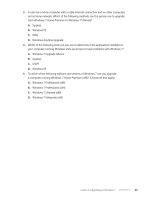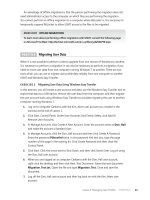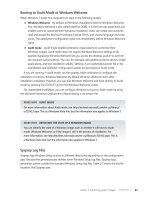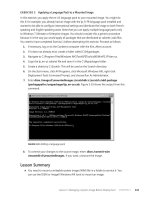Configuring Windows 7 (Training Kit) - Part 41 pdf
Bạn đang xem bản rút gọn của tài liệu. Xem và tải ngay bản đầy đủ của tài liệu tại đây (148.07 KB, 10 trang )
Lesson 3: Network Configuration CHAPTER 6 373
11. Click Close.
12. In Network And Sharing Center, click Connect to a Network. The MyAdHoc network
displays with the message Waiting For Users.
13. Log on to the Canberra computer with a nonadministrative account.
14. Click the Wireless Network icon at the bottom left section of your screen.
15. Right-click MyAdHoc and click Connect.
16. Enter the security key (P@ss1).
17. In the Search box on the Start menu, enter \\Aberdeen. Check that you can see the
shared Test folder.
18. Click the Wireless Network icon at the bottom left section of your screen.
19. Right-click MyAdHoc and click Disconnect. If the Canberra computer was previously
connected to another network, reconnect it.
20. On the Aberdeen computer, disconnect from the MyAdHoc network. Check that the
network is no longer listed on either computer.
Lesson Summary
n
Problems with wireless connectivity can occur if a computer is within range of two
preferred networks or two networks that have the same SSID. Interference from
domestic devices can also cause problems. You can change the channel that a WAP
uses to reduce interference.
n
Using an unsecured wireless network can create significant security risks. If you
configure a wireless network, always ensure that it is secure.
n
You can connect to a wireless network, manage wireless networks, and enable or
disable a wireless adapter through the Network And Sharing Center. You can also use
the Netsh wlan command-line utility to mange wireless networks.
n
Windows 7 configures the default printer that you specify on a particular network
to be the default whenever you connect to that network. Thus, when you switch
networks, you seamlessly shift default printers. You can configure location-aware
printing and specify default printers for specific networks.
Lesson Review
You can use the following questions to test your knowledge of the information in Lesson 3,
“Network Configuration.” The questions are also available on the companion DVD if you
prefer to review them in electronic form.
note ANSWERS
Answers to these questions and explanations of why each answer choice is correct or
incorrect are located in the “Answers” section at the end of the book.
3 7 4 CHAPTER 6 Network Settings
1. One of the users whom you support uses a wireless laptop in the office and also takes
it with her on business trips. She reports that when she uses the laptop in the lounge
area of a hotel in which she frequently stays, she experiences delays and connection
problems. She has no problems when using the laptop in her hotel room or when she
returns to the office. What should you do to help solve the problem?
a. Change the SSID of your office network.
B. Advise the user to change the order in which her laptop attempts to access
preferred networks.
c. Disable network switching on one or both of the preferred networks that the user
connects to in order to access the Internet from her hotel.
D. Update the device driver for the user’s wireless LAN adapter.
2. You want to ensure that only certain designated wireless laptops can connect to your
network. What do you need to enable?
a. MAC address control
B. IPv4 address control
c. WEP
D. WPA
3. You are having problems with a connection and want to run the Windows Network
Diagnostics tool. How can you access this tool? (Choose all that apply.)
a. On the Accessories menu, select System Tools.
B. On the Administrative Tools menu, select Task Scheduler. Schedule the Windows
Network Diagnostic tool to start immediately.
c. In the Network And Sharing Center, click the red X that indicates a failed
connection.
D. Access the Local Area Connections Properties dialog box and click Configure. On
the General tab, click Repair.
e. On the message returned by the browser when it cannot access a Web page, click
Diagnose Connection Problems.
F. Open the Network Connections dialog box by selecting Manage Network
Connections on the Network And Sharing Center. Right-click a connection and
click Diagnose.
4. Don Hall has set up a wireless network at home. He is pleased with the ease with
which he set up her third-party WAP by clicking a single button in the Web interface.
However, his next door neighbor tells him that she can access his network from her
home computer. What should Don do?
a. Enable Windows Firewall
B. Change the security settings of his WAP
c. Change the channel his WAP uses
D. Implement ICS
Lesson 3: Network Configuration CHAPTER 6 375
5. Sam Abolrous hot-desks at the A. Datum Corporation. When he is working at a desk
on the third floor, he wants all his print jobs to go to the printer LaserF3. When he is
working at a desk on the second floor, he wants all his print jobs to go to the printer
LaserF2. The third floor of the A. Datum building is covered by the wireless network
Adatum3. The second floor of the A. Datum building is covered by the wireless network
Adatum2. There is shielding between the floors, and the Adatum2 network cannot
be accessed from the third floor. Similarly, the Adatum3 network cannot be accessed
from the second floor. How do you configure location-aware printing on Sam’s laptop
running Windows 7 Enterprise?
a. Select Always Use The Same Printer As My Default Printer. From the Printers
drop-down list select LaserF2.
B. Select Always Use The Same Printer As My Default Printer. From the Printers
drop-down list, select LaserF3.
c. Select Change My Default Printer When I Change Networks. Select LaserF2 as the
default printer for the Adatum3 network. Select LaserF3 as the default printer for
the Adatum2 network.
D. Select Change My Default Printer When I Change Networks. Select LaserF2 as the
default printer for the Adatum2 network. Select LaserF3 as the default printer for
the Adatum3 network.
3 7 6 CHAPTER 6 Network Settings
Chapter Review
To further practice and reinforce the skills you learned in this chapter, you can perform the
following tasks:
n
Review the chapter summary.
n
Review the list of key terms introduced in this chapter.
n
Complete the case scenarios. These scenarios set up real-world situations involving the
topics of this chapter and ask you to create a solution.
n
Complete the suggested practices.
n
Take a practice test.
Chapter Summary
n
IPv4 routes packets within a subnet and over an intranetwork. IPv6 performs the same
functions as IPv4 but also addresses the problems associated with the earlier protocol,
such as lack of address space.
n
You use Network And Sharing Center and Netsh commands to configure networks
and network connections, and connect to networks. You can access Windows Network
Diagnostics by using Network And Sharing Center.
n
Network command-line diagnostic tools include Ping, Tracert, Pathping, and Netstat.
Windows Network Diagnostics can solve many network problems automatically.
n
Windows 7 offers an enhanced printing experience, including location-aware printing.
Key Terms
Do you know what these key terms mean? You can check your answers by looking up the
terms in the glossary at the end of the book.
n
default gateway
n
global address
n
IP address
n
IP packet
n
preferred wireless network
n
public address
n
subnet
n
subnet mask
Case Scenarios CHAPTER 6 377
Case Scenarios
In the following case scenarios, you apply what you’ve learned about network settings. You
can find answers to these questions in the “Answers” section at the end of this book.
Case Scenario 1: Implementing IPv4 Connectivity
Your friend runs a small business from home. Until recently, he used a single computer
running Windows 7 and connected directly to his cable modem to access the Internet. His
business has expanded, and now he uses three computers. He has connected them with an
Ethernet hub and connects to his modem through a USB cable.
Answer the following questions:
1. Your friend calls you and reports that the computer connected to the modem can
access the Internet, but the others cannot. What do you advise?
2. He calls you for more advice. He has purchased a wireless computer and a WAP. He
wants to know how he can use this computer on his network while still using his three
desktop computers that have only wired connections. What do you advise?
Case Scenario 2: Implementing IPv6 Connectivity
You are a network administrator at Blue Sky Airlines. Your corporate network consists of two
subnets with contiguous private IPv4 networks configured as virtual local area networks
(VLANs) connected to a layer-3 switch. Blue Sky Airlines accesses its ISP and the Internet
through a dual-homed server running Microsoft Internet Security and Acceleration (ISA) that
provides NAT and firewall services and connects through a peripheral zone to a hardware
firewall and, hence, to its ISP. All user workstations run Windows 7 Enterprise. The company
wants to implement IPv6 connectivity. All the network hardware supports IPv6, as does the ISP.
Answer the following questions:
1. What options are available for the type of unicast address used on the subnets?
2. You know your clients running Windows 7 have IPv6 enabled by default. Your
site-local addresses are allocated through stateful configuration (by DHCPv6),
but on entering ipconfig /all on a client computer, you see the address 2001::
ce49:7601:e866:efff:f5ff:ebfe. What type of address is this, and what is its function?
Case Scenario 3: Using Laptop Computers Running
Windows 7 on Wireless Networks
You are a network administrator at Margie’s Travel. You are planning to upgrade all client
computers to laptops running Windows 7 Enterprise. All clients will connect wirelessly, and
employees are expected to have wireless networks at home and to work from home and in
the office.
3 7 8 CHAPTER 6 Network Settings
Answer the following questions:
1. A senior staff member is concerned that she needs to switch her default printer from
the printer that she uses in the office to a wireless network inkjet printer that she uses
at home. What do you advise her?
2. The same employee intends to replace her home printer with a newer model. She
asks you to grant her account local administrator privileges so she can install the new
printer. What do you tell her?
3. The main office at Margie’s Travel has two wireless networks. Employees can typically
move between one area of the office to another without losing connectivity. However,
one employee complains of poor service when she is seated at her desk, though she
has no problem if she moves to another part of the building. How do you solve this
problem?
Suggested Practices
To help you master the exam objectives presented in this chapter, complete the following
tasks.
Configure IPv4
n
Practice 1 You can do a lot with the versatile and powerful Network And Sharing
Center. Investigate all its functions thoroughly and become familiar with its screens,
wizards, and dialog boxes.
n
Practice 2 Become familiar with all the switches available with Ping, Tracert, Ipconfig,
Pathping, and Netstat. Use the command-line help (for example, ping /?).
n
Practice 3 Create some problems on your interfaces (for example, by unplugging
Ethernet cables and misconfiguring adapters). Use the Windows Network Diagnostic
tool to find these problems.
n
Practice 4 Use the help function in the Command Prompt console to investigate
the Netsh interface ipv4 set, Netsh interface ipv4 add, and Netsh interface ipv4 show
commands. Also, investigate the Netsh dhcp commands.
Configure IPv6
n
Practice 1 You should be able to look at an IPv6 address and tell whether it is global,
link-local, site-local, or multicast. Teredo, 6to4, and ISATAP addresses are slightly more
difficult to identify but you can become proficient at this with practice. Look at lists of
addresses. The Ipconfig /all utility is a good place to start.
n
Practice 2 Use the help function in the Command Prompt console to investigate
the Netsh interface ipv6 set, Netsh interface ipv6 add, and Netsh interface ipv6 show
commands.
Take a Practice Test CHAPTER 6 379
Configure Networks
n
Practice 1 Although you might not use every function that a third-party WAP
configuration Web interface dialog box provides, make sure you know what wireless
access settings are available. Become familiar with the configuration pages (or tabs) on
your interface and with the manufacturer’s documentation.
n
Practice 2 Use the Command Prompt help function to learn the syntax of the Netsh
wlan add, Netsh wlan connect, Netsh wlan delete, Netsh wlan disconnect, Netsh wlan
dump, Netsh wlan export, Netsh wlan refresh, Netsh wlan reportissues, Netsh wlan
set, Netsh wlan show, Netsh wlan start, and Netsh wlan stop commands. Use these
commands to manage wireless networks.
n
Practice 3 Windows 7 offers improvements in print quality and enhanced print
management. Investigate the facilities available from the Devices And Printers
dialog box.
Take a Practice Test
The practice tests on this book’s companion DVD offer many options. For example, you
can test yourself on just one exam objective, or you can test yourself on all the 70-680
certification exam content. You can set up the test so that it closely simulates the experience
of taking a certification exam, or you can set it up in study mode so that you can look at the
correct answers and explanations after you answer each question.
More Info PRACTICE TESTS
For details about all the practice test options available, see the section entitled “How to
Use the Practice Tests,” in the Introduction to this book.
CHAPTER 7 381
CHAPTER 7
Windows Firewall
and Remote Management
F
irewalls are important. From the moment that your computer connects to a public
network, automated scanners probe its network interfaces looking for weaknesses to
exploit. Today’s computer user is much more likely to access a publically accessible Wi-Fi
network, either in a coffee shop or in an airport lounge. When you connect to the free Wi-Fi
network at the coffee shop, you do not know if someone sitting a couple of tables away
is running a port scanner looking for vulnerabilities in your computer’s security. You need
a firewall all the time, not just when connected to a public network. You need it active when
you are connected to your corporate network because you cannot be sure if a member
of the sales team, who takes her laptop with her wherever she goes, might have had her
machine compromised when she was not being careful. If a compromised computer
connects to a network where other clients do not have firewalls enabled, it will not be long
until that infected computer compromises all the unprotected computers on the network.
As IT departments are asked to do more with less, support staffs have less time to
perform on-site visits to resolve customer technical issues. It is increasingly necessary to be
able to resolve as many client maintenance issues as you can remotely from the helpdesk
rather than having to visit each computer that is the subject of a support ticket. Windows 7
makes this easier. Not only do clients running Windows 7 support Remote Desktop and
Windows Remote Assistance, it is now possible to run Windows PowerShell scripts and
command-line utilities against properly configured clients, giving support staff even more
options when it comes to resolving maintenance issues.
Exam objectives in this chapter:
n
Configure Windows Firewall.
n
Configure Remote Management.
Lessons in this chapter:
n
Lesson 1: Managing Windows Firewall 383
n
Lesson 2: Windows 7 Remote Management 402
3 8 2 CHAPTER 7 Windows Firewall and Remote Management
Before You Begin
To complete the exercises in the practices in this chapter, you need to have done the following:
n
Installed Windows 7 on a stand-alone client PC named Canberra, as described in
Chapter 1, “Install, Migrate, or Upgrade to Windows 7.”
n
Installed Windows 7 on a stand-alone client PC named Aberdeen, as described in
Chapter 6, “Network Settings.”
real World
Orin Thomas
I
t is probably a good thing that remote management technologies were still in
their infancy back when I was doing first-level support. Back when I was working
Helpdesk at an Australian university, I had to do a lot of walking across a very
large campus to assist people with computer problems in far-flung departments.
So even though I had to walk past the donut shop on my way out to visit a broken
computer, I felt better about it because at least I was out in the air getting some
exercise. If I was back in that job today and had the plethora of remote assistance
technologies built into Windows 7 available, it would have been less necessary to
leave my desk. Rather than having to walk from my office to the Department of
Social Work to assist someone because “the mail-merge thingy won’t go in the
doodad,” I would be able to use Remote Assistance to see exactly what that person
could see on the screen and guide him through the process. I could have performed
many maintenance tasks using Remote Desktop or Windows PowerShell rather than
having to go from office to office applying updates and resolving configuration
settings manually. If today’s remote management technologies had existed back
then, I would rarely have left my desk and would not have gotten any exercise at all.


